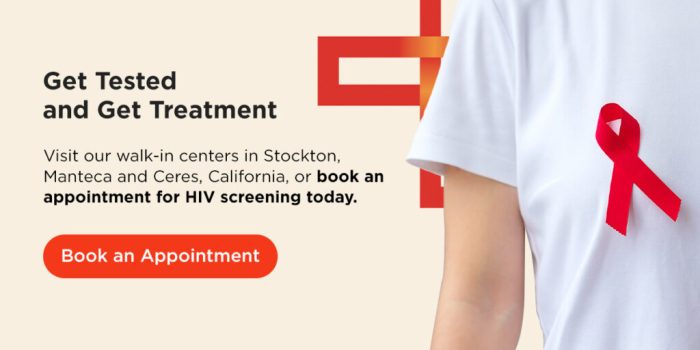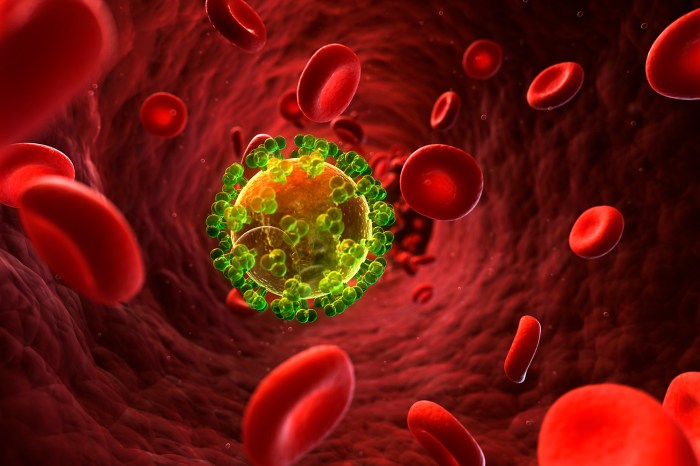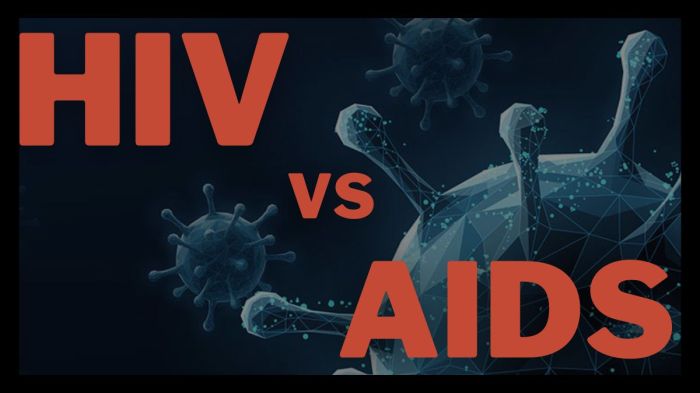Which HIV tests are the most accurate? This question is crucial for ensuring accurate diagnoses and appropriate health management. Different HIV tests employ various methods, each with its own strengths and weaknesses regarding sensitivity, specificity, and speed. Understanding these differences is vital for making informed decisions about testing, and ultimately, for protecting your health. This exploration will delve into the complexities of HIV testing accuracy, from the basics of different testing types to the nuances of interpreting results and the limitations of current methods.
Accurate HIV testing is essential for early detection and treatment. Different tests utilize various methods, ranging from simple rapid tests to more complex laboratory procedures. Factors like the stage of infection, individual health status, and the testing environment can influence test accuracy. This article provides a comprehensive overview of various HIV tests, highlighting their strengths, weaknesses, and limitations.
Introduction to HIV Testing Accuracy
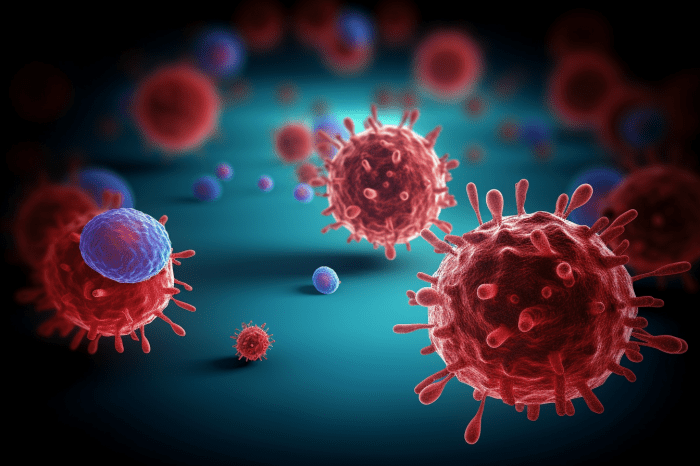
Accurate HIV testing is crucial for early diagnosis and effective management of the infection. Early diagnosis allows for prompt initiation of antiretroviral therapy (ART), significantly improving the quality of life and reducing the risk of transmission. This, in turn, impacts public health outcomes, as early intervention helps prevent further spread of the virus. The accuracy of different testing methods directly affects the reliability of these diagnoses.The significance of different testing methods lies in their ability to detect the presence or absence of HIV antibodies or viral genetic material.
Different tests employ various techniques and have varying degrees of sensitivity and specificity. Understanding these differences is essential for healthcare providers to choose the most appropriate test for a given situation and for individuals to make informed decisions about their health.
Types of HIV Tests
Various types of HIV tests are available, each with its own strengths and weaknesses. These tests generally fall into two categories: antibody tests and nucleic acid tests (NATs). Antibody tests detect antibodies produced by the body in response to HIV infection, while NATs detect the HIV virus itself. The choice of test often depends on the context, the urgency of the need for a result, and the resources available.
Comparison of HIV Testing Methods
| Test Type | Principle | Sensitivity | Specificity | Time to Result |
|---|---|---|---|---|
| Rapid Antibody Tests | Detect HIV antibodies in a person’s blood or oral fluid using a lateral flow assay. Results are available in minutes. | High, typically 90-99% | High, typically 99-100% | 15-30 minutes |
| ELISA (Enzyme-Linked Immunosorbent Assay) | A blood test that detects HIV antibodies by using an enzyme-linked antibody to bind to the detected antibodies. | High, typically 95-99% | High, typically 99-100% | 1-2 days |
| Western Blot | Confirmatory test for HIV infection. Identifies specific HIV proteins in the blood sample. | High, typically 99% | Very high, typically 99.99% | 1-2 days |
| Nucleic Acid Tests (NATs) | Detect the presence of HIV viral RNA (genetic material) in a blood sample. | Very high, often greater than 99% | High, typically 99-100% | 1-2 days |
The table above summarizes the key characteristics of common HIV testing methods. Sensitivity refers to the test’s ability to correctly identify individuals with HIV, while specificity refers to its ability to correctly identify individuals without HIV. Time to result is crucial, especially in situations where a rapid diagnosis is needed for immediate treatment.
Factors Affecting Test Accuracy: Which Hiv Tests Are The Most Accurate
HIV testing, while highly reliable, isn’t foolproof. Numerous factors can influence the accuracy of the results, impacting the reliability of diagnosis. Understanding these factors is crucial for both individuals seeking testing and healthcare professionals administering it. Knowing what can affect the test’s outcome empowers informed decision-making and ensures appropriate follow-up.Factors like the stage of infection, overall health, and even the testing environment can all impact the test’s ability to detect the virus accurately.
This section delves into these critical aspects to highlight the nuances of HIV testing.
Stage of Infection and Test Sensitivity
The time elapsed since infection significantly affects the detection of HIV. In the initial stages, the viral load, the amount of HIV in the blood, might be low, making it harder for some tests to detect. This early period, sometimes called the “window period,” can delay a positive result. Conversely, as the infection progresses and the viral load increases, the chances of a positive result through various testing methods become much higher.
Different tests have varying degrees of sensitivity in detecting the virus at different stages.
Figuring out the most accurate HIV tests can be tricky, but thankfully, there are reliable options available. While various tests exist, the combination/multi-antigen/antibody tests generally boast the highest accuracy. Speaking of health, did you know that magnesium plays a surprising role in blood pressure regulation? Check out this fascinating article on the surprising ways magnesium helps to lower blood pressure for more on that! Ultimately, choosing the right HIV test is key for early detection and treatment.
Individual Health Status and Test Accuracy
A person’s overall health condition can impact test results. For example, individuals with weakened immune systems, such as those with conditions like cancer or undergoing chemotherapy, may have different viral loads than those with healthy immune systems. This variation can affect the test’s ability to detect the virus accurately. Similarly, concurrent infections or medications can sometimes interfere with the testing process, leading to either false-positive or false-negative results.
A comprehensive medical history is essential for accurate interpretation of results.
Testing Environment and Procedure
The testing environment and the procedure itself play a crucial role in achieving accurate results. Proper handling of the sample, from collection to analysis, is essential. Errors in collection, inadequate storage, or improper laboratory procedures can all introduce inaccuracies. Trained personnel and well-maintained equipment are vital to ensure reliable results. Furthermore, the individual’s emotional state and the environment they are in can influence the quality of the sample, affecting the test outcome.
Importance of Proper Test Procedures
The accuracy of any diagnostic test hinges on adhering to established procedures. Rigorous protocols ensure that samples are handled correctly, minimizing the potential for contamination and maximizing the reliability of results. A trained technician who follows the established testing guidelines is critical for precise analysis and interpretation of the test results.
Accuracy Comparison Across Infection Stages
| Test Type | Stage of Infection | Sensitivity | Specificity |
|---|---|---|---|
| ELISA | Early Infection | Moderate | High |
| ELISA | Chronic Infection | High | High |
| Western Blot | Early Infection | Low | Very High |
| Western Blot | Chronic Infection | High | Very High |
| RNA PCR | Early Infection | High | High |
| RNA PCR | Chronic Infection | High | High |
Note: Sensitivity and Specificity are expressed as percentages and are affected by the stage of infection. This table is a general representation and specific values may vary based on the specific test used and the laboratory’s performance.
Types of HIV Tests and Their Accuracy
Understanding the different types of HIV tests and their respective accuracy is crucial for effective diagnosis and management of the infection. Different tests are suited to various situations, from initial screening to confirming a diagnosis or monitoring treatment response. This section delves into the specifics of these tests, their strengths, and limitations.
Common Types of HIV Tests
Various types of HIV tests exist, each employing a different method to detect the presence of HIV. These tests differ in their speed, cost, and the stage of infection they are best suited for. A crucial aspect of HIV testing is selecting the appropriate test based on the specific context.
- Rapid Tests: These tests provide results in minutes, making them ideal for point-of-care settings. They typically detect antibodies produced by the body in response to the HIV virus. Rapid tests are generally accurate when used correctly by trained personnel. However, they may not be as sensitive in the very early stages of infection when antibody levels are still low.
- Antibody Tests: These tests are widely used and generally accurate. They detect antibodies produced by the body in response to HIV infection. They are often performed in a laboratory setting and provide results within a few days. The accuracy of antibody tests improves as the body’s immune response develops.
- Antigen/Antibody Combination Tests: These tests combine the detection of both HIV antibodies and p24 antigen, a protein produced by the virus. This combination allows for earlier detection than antibody-only tests, as the p24 antigen can be present in the blood before antibodies are detectable. This approach enhances the test’s sensitivity, making it useful in the early stages of infection.
- Nucleic Acid Tests (NATs): NATs are highly sensitive and can detect the HIV virus’s genetic material (RNA) in the blood. They are considered the gold standard for confirming a diagnosis, especially in the early stages of infection. NATs are typically used when there is a suspicion of recent infection or if the results of other tests are unclear.
Accuracy Comparison of Different HIV Test Types
The accuracy of a test is often measured by its sensitivity and specificity. Sensitivity refers to the test’s ability to correctly identify people with HIV, while specificity refers to its ability to correctly identify people without HIV. A highly sensitive and specific test minimizes false positives and false negatives.
| Test Type | Accuracy | Speed | Cost | Accessibility |
|---|---|---|---|---|
| Rapid Tests | High, but may vary depending on the test | Very Fast (minutes) | Generally Moderate | High (point-of-care) |
| Antibody Tests | High | Moderate (days) | Moderate | High (laboratory settings) |
| Antigen/Antibody Combination Tests | High, with enhanced sensitivity | Moderate (days) | Moderate | High (laboratory settings) |
| Nucleic Acid Tests (NATs) | Highest sensitivity and specificity | Moderate (days) | High | Moderate (laboratory settings) |
Accuracy and reliability of HIV tests are crucial aspects of public health.
Knowing which HIV tests are most accurate is crucial, but taking care of your overall health is equally important, especially if you’re facing a condition like metastatic breast cancer. Checking out lifestyle tips for metastatic breast cancer can help you understand the importance of a balanced approach to health. Ultimately, various factors influence the accuracy of HIV tests, and different tests are designed for various needs.
A healthcare professional can recommend the most suitable test for your situation.
Role of Different Test Types in Different Stages of HIV Infection
The appropriate HIV test type depends on the stage of infection. Rapid tests are useful for initial screening, while antibody tests can be used for confirmation. Antigen/antibody combination tests are better for detecting recent infections, and NATs are the gold standard for confirming early infection and monitoring treatment response.
Interpreting HIV Test Results
Understanding your HIV test results is crucial for managing your health and well-being. Accurate interpretation is not only about understanding the result itself, but also about recognizing the importance of follow-up care and potential next steps. This section delves into the process of interpreting HIV test results, from positive and negative outcomes to the crucial role of confirmation testing.Interpreting a test result involves more than just a simple ‘positive’ or ‘negative’.
While various HIV tests exist, some are undeniably more accurate than others. It’s crucial to choose a test from a reputable lab, and to ensure the process is properly carried out. Speaking of burning calories, have you ever considered how many calories you burn just by standing? Learning about the energy expenditure involved in standing might help you to better understand your overall health.
For more on the topic of does standing burn calories , check out this insightful article. Regardless of the method, seeking a certified test with proven accuracy is always the best way to approach HIV testing.
The specific type of test performed, the individual’s health history, and potential exposure factors all contribute to a comprehensive understanding of the outcome. Understanding these nuances empowers individuals to make informed decisions about their health.
Understanding Positive Results
A positive HIV test result indicates the presence of antibodies or antigens associated with HIV in the body. This doesn’t necessarily mean immediate onset of AIDS. The presence of these markers suggests a prior or current infection. This is a significant moment that warrants immediate attention and careful follow-up. A crucial next step is confirmation testing.
Confirmation Testing for a Positive Result
Confirmation testing is essential for verifying a positive HIV test result. This process typically involves a different, more specific test, often utilizing a different method than the initial screening test. The confirmation test is designed to reduce the possibility of a false positive result. This second test is crucial in providing a more definitive answer.Different types of confirmation tests exist, including enzyme immunoassays (EIAs) and Western blot assays.
These methods employ various techniques to identify specific HIV markers, increasing the accuracy of the diagnosis. For example, a Western blot test looks for specific proteins associated with HIV, providing a more detailed analysis than an initial screening test.
Understanding Negative Results
A negative HIV test result indicates the absence of detectable antibodies or antigens associated with HIV at the time of testing. It’s important to remember that a negative result doesn’t guarantee immunity. Recent infection might not have had enough time to produce detectable antibodies. It is advisable to consider one’s recent exposure history and consult a healthcare professional for personalized advice.
Interpreting Indeterminate or Unclear Results
An indeterminate or unclear result necessitates further testing and careful consideration. These results typically occur when the initial screening test shows some evidence of antibodies or antigens, but not enough to definitively confirm or deny HIV infection. Follow-up testing is critical to ensure an accurate diagnosis.In cases of indeterminate results, repeated testing is often recommended. A second test, using a different method, can provide more definitive information.
This is crucial to prevent any false interpretations. Medical professionals will also assess factors such as recent exposure history and overall health status.
Importance of Follow-up Testing
Follow-up testing is essential for individuals with indeterminate or unclear results. This is because the presence of HIV antibodies or antigens might not be detectable in the early stages of infection. It is also important for those who have had a recent potential exposure.
Table of Possible HIV Test Results
| Result | Interpretation | Next Steps |
|---|---|---|
| Negative | No detectable HIV antibodies or antigens at the time of testing. | Continued monitoring if a recent exposure occurred; consult a healthcare professional for personalized advice. |
| Positive | Presence of HIV antibodies or antigens; requires confirmation testing. | Confirmation testing using a different method; immediate medical consultation. |
| Indeterminate/Unclear | Suggests possible infection but needs further investigation. | Repeated testing using a different method; consultation with a healthcare professional. |
Limitations of HIV Tests
HIV testing is a crucial tool in the fight against HIV, but it’s important to understand its limitations. While highly accurate, no test is perfect, and understanding these limitations is essential for interpreting results correctly and ensuring appropriate follow-up. A false positive or negative result can have significant implications for individuals and public health efforts.Understanding the limitations of HIV testing is vital for both individuals and healthcare providers.
This allows for informed decision-making, appropriate counseling, and the implementation of necessary strategies to address potential inaccuracies. The following sections will delve into the specific limitations of various HIV testing methods, emphasizing the importance of considering these factors in the interpretation of results.
Window Periods
The window period is the time between infection with HIV and when a test can reliably detect the virus. During this period, the body may not yet have produced enough detectable antibodies or antigens for the test to accurately identify the infection. This time frame varies depending on the specific type of test.Different HIV tests have varying window periods.
Some tests can detect the virus earlier than others. For instance, some rapid antibody tests have a window period of around two to four weeks, while more sophisticated tests can potentially detect infection within a shorter period. It’s crucial to understand the window period of a particular test to ensure that a negative result during this timeframe does not rule out the possibility of recent infection.
Individuals who engage in high-risk behaviors should be aware of the window period of the test used and consider retesting if necessary.
False Positives
False positives occur when a test indicates the presence of HIV infection, even though the person is not actually infected. This can be caused by various factors, such as cross-reactivity with other antibodies, certain medical conditions, or even the test itself.The occurrence of false positives in HIV testing can be minimized by employing stringent testing procedures and protocols. Proper handling of specimens, adherence to standardized testing procedures, and rigorous quality control measures are essential.
Moreover, confirmatory testing is crucial in case of a positive result to ensure the accuracy of the diagnosis. For example, a rapid antibody test that yields a positive result should always be followed by a more sensitive confirmatory test, such as an ELISA or Western blot.
False Negatives
False negatives occur when a test indicates the absence of HIV infection, even though the person is actually infected. This can happen if the viral load is too low to be detected at the time of testing, or if the test used is not sensitive enough to detect the virus.Understanding the possibility of false negatives is critical, especially in situations where an individual has a recent potential exposure to HIV.
For example, in cases of suspected recent exposure, retesting after a certain period, guided by the window period of the test, may be necessary. Additionally, if an individual has symptoms suggestive of HIV infection but receives a negative test result, further evaluation and consideration of other factors should be undertaken.
Summary of Limitations
| Test Type | Window Period | Potential False Positives | Potential False Negatives |
|---|---|---|---|
| Rapid Antibody Tests | 2-4 weeks | Possible cross-reactivity with other antibodies | Possible if viral load is low or test is not sensitive enough |
| ELISA (Enzyme-Linked Immunosorbent Assay) | 2-6 weeks | Less frequent than rapid tests but possible | Possible if viral load is low or test is not sensitive enough |
| Western Blot | 2-6 weeks | Rare | Rare |
Future Directions in HIV Testing
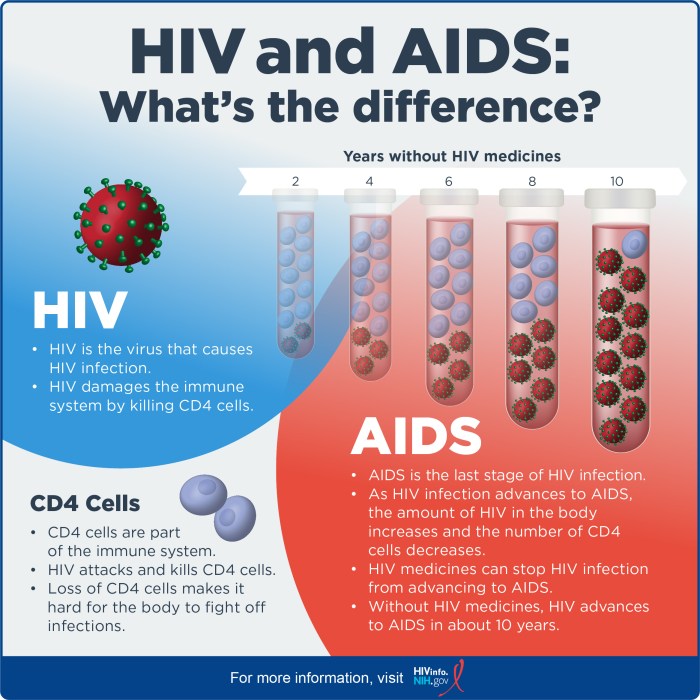
The quest for improved HIV testing continues, driven by the desire for more accurate, efficient, and accessible options. Current research and development efforts are focused on overcoming limitations of existing methods and expanding testing capabilities to reach underserved populations. This exploration promises to significantly enhance HIV diagnosis and management globally.
Current Research and Development Efforts
Research in HIV testing is exploring various avenues, from innovative diagnostic tools to novel approaches for point-of-care testing. Scientists are investigating new technologies and methodologies with the aim of developing faster, more accurate, and less expensive tests. This includes leveraging advancements in molecular biology, nanotechnology, and artificial intelligence to create more sophisticated diagnostic platforms.
Potential Advancements in HIV Testing
Several advancements in HIV testing technology could revolutionize the field. One promising area is the development of highly sensitive tests that can detect HIV earlier in the infection cycle. This early detection could allow for prompt initiation of antiretroviral therapy (ART), thereby significantly improving patient outcomes. Another significant advancement is the development of tests that can differentiate between different HIV subtypes, which will enhance epidemiological surveillance and treatment strategies.
Additionally, research is focusing on developing multiplex tests that can detect multiple infectious agents simultaneously, including HIV, which will facilitate more comprehensive disease management.
Accessible and Affordable HIV Testing Options, Which hiv tests are the most accurate
The accessibility and affordability of HIV testing are crucial for widespread adoption and effective disease control. To achieve this, researchers are working on developing simple, user-friendly, and low-cost tests. Furthermore, point-of-care (POC) testing is rapidly evolving, with the potential to significantly increase access in resource-limited settings. POC tests can be performed outside of laboratory settings, by trained personnel or even by patients themselves, offering immediate results and facilitating timely intervention.
Development of Point-of-Care HIV Tests
Point-of-care (POC) HIV tests are increasingly important for improving access to testing in diverse settings. These tests are designed for use outside of traditional laboratory environments, allowing for testing in clinics, community health centers, or even at home. POC tests offer immediate results, enabling rapid initiation of treatment and reducing the time to diagnosis. A crucial aspect of POC development is ensuring accuracy and reliability, while also maintaining affordability and ease of use.
The future of HIV testing is poised to be transformed by the continued innovation and implementation of POC tests, particularly in resource-constrained settings. This will greatly improve the lives of people living with HIV, promoting earlier diagnosis and intervention.
Final Thoughts
In conclusion, determining the “most accurate” HIV test depends on specific circumstances. No single test reigns supreme in all situations. Factors like the stage of infection, individual health, and desired speed of results play critical roles. Rapid tests offer quick results, while more complex tests provide higher accuracy. Ultimately, understanding the limitations of each test and the importance of proper testing procedures are key to obtaining reliable results.
The discussion also highlighted the crucial role of follow-up testing and confirmation procedures in ensuring accurate diagnoses. Ongoing research and development are vital to improve testing accuracy and accessibility.


